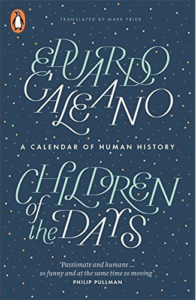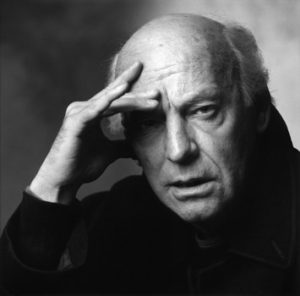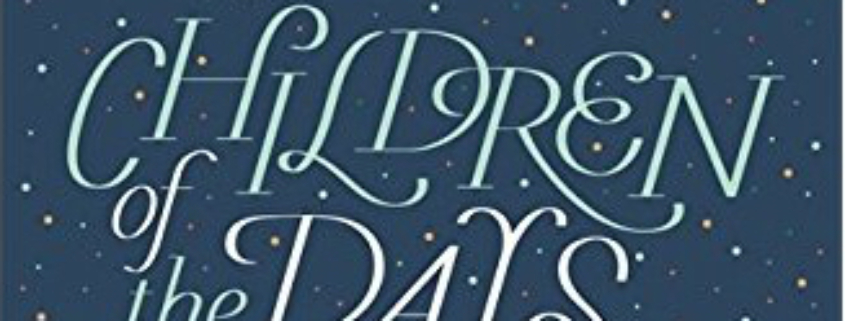Writers Read: Children of the Days by Eduardo Galeano
 Children of the Days: A Calendar of Human History consists of a series of 366 vignettes, one for each day of the Roman calendar year, not noticeably related to one another, which create a mosaic of fractured memories of human history. The volume continues the late Uruguayan writer Eduardo Galeano’s Hegelian approach to understanding and articulating Latin American political culture, embodying both history’s bloodiest examples of human brutality and literature’s most exquisite cases of humanity. Like Galeano’s previous works, including The Open Veins of Latin America and Memory of Fire, the dated entries that comprise Children of the Days blend fiction, journalism, history, poetry, and memoir to recall and give voice to the great and small voices of global history.
Children of the Days: A Calendar of Human History consists of a series of 366 vignettes, one for each day of the Roman calendar year, not noticeably related to one another, which create a mosaic of fractured memories of human history. The volume continues the late Uruguayan writer Eduardo Galeano’s Hegelian approach to understanding and articulating Latin American political culture, embodying both history’s bloodiest examples of human brutality and literature’s most exquisite cases of humanity. Like Galeano’s previous works, including The Open Veins of Latin America and Memory of Fire, the dated entries that comprise Children of the Days blend fiction, journalism, history, poetry, and memoir to recall and give voice to the great and small voices of global history.
Many who have reviewed Children of the Days have sought entry to the text via their birthdates, which is as reasonable a way to begin interrogating the text as any. The entry for my own birthday, April 26, is “Nothing Happened Here.” It concerns the Chernobyl nuclear accident that occurred in 1986, which caused radioactive rain to fall over much of Europe. In a recent New York Times article, Henry Fountain refers to the accident as a “huge dirty bomb, an explosion that spewed radioactive material in all directions.” Smoke from the fire that followed the initial blast carried the radioactive material and additional contaminants into the atmosphere and, thanks to the region’s long-range wind systems, over much of Western Europe.
I distinctly remember following the radioactive cloud in the news as well as on the ground. The cloud missed Spain, where I spent the month of April 1986…
Although Galeano claims that virtually no government reported on this geographically and temporally extended emergency, I distinctly remember following the radioactive cloud in the news as well as on the ground. The cloud missed Spain, where I spent the month of April 1986, and passed over southern England before I returned to school there at the end of May. Yet, Galeano’s interpretation has merit. The Soviet Union was notoriously secretive. Soviet officials refused to admit that the accident had occurred until April 28, when Swedish officials demanded to know what was causing the increased levels of radiation within their borders. Even today, cover-up theories persist. Fedor Alexandrovich’s film, The Russian Woodpecker, premiered at the Sundance Festival earlier this year. The film’s premise is that the Chernobyl accident served to cover up a 14,000-ton military radar installation in northern Ukraine, near the border with Belorussia, right next to the Chernobyl Atomic Energy Station.

Eduardo Galeano
The juxtaposition of Galeano’s lyrical history with contemporary journalistic and scholarly analyses of the Chernobyl accident are instructive with respect to grasping the meaning and veracity of the entries to Children of the Days. Each entry captures a truth about the substantive event or circumstance of interest, though it may or may not be entirely factual. The tension between truth, or interpretation, on the one hand, and historical fact on the other is likely complicated by the translator’s prerogatives. Galeano was, firstly, a gifted writer and political progressive heralded for his alternative historiographies, of Latin America in particular, that gave voice to the poor, the persecuted, the illiterate, and the nameless as well as their wealthier, well-known leaders. The translator of this text, Mark Fried, is to be credited for conveying Galeano’s beautifully written and widely accessible truths. This reader is not alone in being perfectly capable of fact checking insofar as it might be necessary to cite Galeano’s history.
References
Fountain, Henry. “Chernobyl: Capping a Catastrophe.” The New York Times. The New York Times, 27 April 2014. Web. 17 July 2015.
Friedman, Sharon M. “Three Mile Island, Chernobyl, and Fukushima: An Analysis of Traditional and New Media Coverage of Nuclear Accidents and Radiation.” Bulletin of the Atomic Scientists 67.5 (2011): 55-64.
The Russian Woodpecker. Dir. Chad Gracia. Sundance Film Festival, 2015. Film.


 Juliann Allison is a feminist scholar, environmentalist, homeschool advocate, yogini, runner, rock climber, mate, and mother of four with a passion for the outdoors. She is Associate Professor of Gender and Sexuality Studies and Public Policy at UC Riverside, and an MFA student at Antioch University Los Angeles.
Juliann Allison is a feminist scholar, environmentalist, homeschool advocate, yogini, runner, rock climber, mate, and mother of four with a passion for the outdoors. She is Associate Professor of Gender and Sexuality Studies and Public Policy at UC Riverside, and an MFA student at Antioch University Los Angeles.


